Moderate overlap front: original test
Rating applies to 2005-09 models built after January 2005
Tested vehicle: 2005 Kia Spectra EX 4-door
The Kia Spectra was redesigned during the 2004 model year. (The old design was produced through November 2003; these cars are also designated as 2004 models.) All 2004 and later Spectra models manufactured after November 2003 are the redesigned cars. (Information about when a specific vehicle was manufactured is on the certification label typically affixed to the car on the driver door or adjacent B-pillar.)
The Institute evaluated a 2004 Spectra manufactured after November 2003. Forces on the head and neck were high, leading to a marginal head/neck injury rating. This rating, along with acceptable or marginal ratings for the chest and both legs, contributed to a poor overall rating. In response, Kia reduced the size of the driver airbag vent holes to lessen the injury forces occurring on the head and neck. Cars manufactured after January 2005 are equipped with the new airbag design.
The evaluation of the Spectra below is based on the test of a 2005 model built before January 2005 but retrofitted prior to the test with the redesigned airbag. However, because no structural changes were made, the structure rating is based on tests of both the 2005 and 2004 models.
| Evaluation criteria | Rating |
|---|---|
| Overall evaluation | |
| Structure and safety cage | |
| Driver injury measures | |
| Head/neck | |
| Chest | |
| Leg/foot, left | |
| Leg/foot, right | |
| Driver restraints and dummy kinematics Dummy movement was reasonably well controlled. During rebound, the dummy's head moved partway out the open side window and hit the B-pillar. |
|
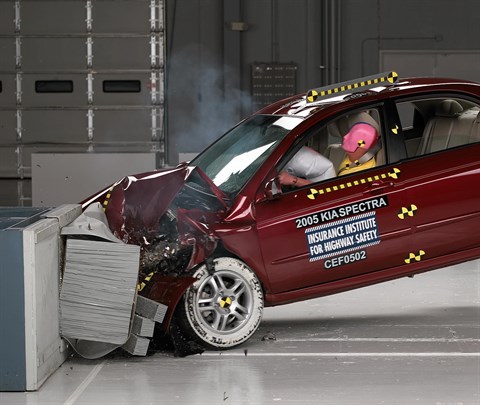
Action shot taken during the frontal offset crash test. The dummy's head is beginning to move through the open side window after the head rebounded from the airbag.
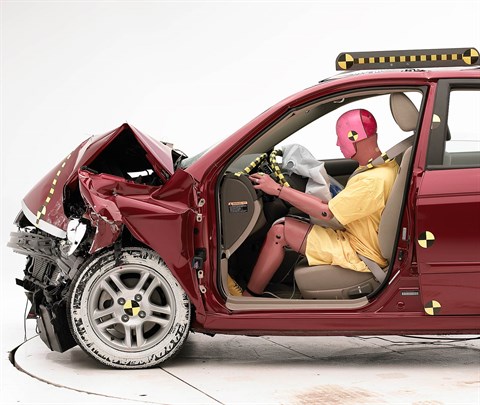
The dummy's position in relation to the steering wheel and instrument panel after the crash test of the 2005 model indicates that the driver's survival space was maintained well.

Smeared greasepaint indicates where the dummy's head hit the B-pillar and head restraint during rebound. Head accelerations from these hits were low.
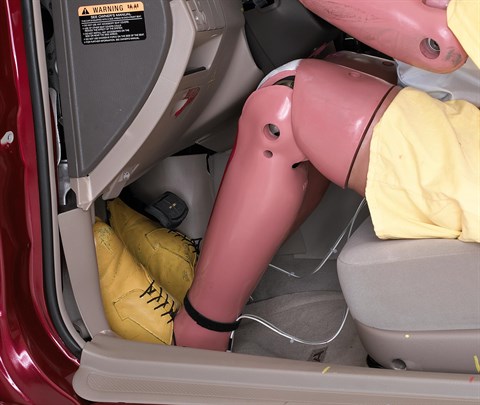
Forces on both lower legs were high enough to indicate the possibility of injuries.
Measures of occupant compartment intrusion on driver side
| Evaluation criteria | Measurement | |
|---|---|---|
| Test ID | CEF0417 | CEF0502 |
| Footwell intrusion | ||
| Footrest (cm) | 18 | 12 |
| Left (cm) | 20 | 20 |
| Center (cm) | 18 | 17 |
| Right (cm) | 15 | 14 |
| Brake pedal (cm) | 16 | 15 |
| Instrument panel rearward movement | ||
| Left (cm) | 5 | 5 |
| Right (cm) | 5 | 4 |
| Steering column movement | ||
| Upward (cm) | 5 | 3 |
| Rearward (cm) | 0 | 1 |
| A-pillar rearward movement (cm) | 2 | 2 |
Driver injury measures
| Evaluation criteria | Measurement | |
|---|---|---|
| Test ID | CEF0502 | |
| Head | ||
| HIC-15 | 383 | |
| Peak gs at hard contact | 80 | |
| Neck | ||
| Tension (kN) | 2.5 | |
| Extension bending moment (Nm) | 32 | |
| Maximum Nij | 0.54 | |
| Chest maximum compression (mm) | 25 | |
| Legs | ||
| Femur force - left (kN) | 0.4 | |
| Femur force - right (kN) | 4.9 | |
| Knee displacement - left (mm) | 0 | |
| Knee displacement - right (mm) | 3 | |
| Maximum tibia index - left | 1.05 | |
| Maximum tibia index - right | 0.84 | |
| Tibia axial force - left (kN) | 2.0 | |
| Tibia axial force - right (kN) | 4.2 | |
| Foot acceleration (g) | ||
| Left | 63 | |
| Right | 120 | |
Side: original test
Rating applies to 2004-08 models built after November 2003 and before September 2007
Tested vehicle: 2004 Kia Spectra EX 4-door with standard front and rear head curtain airbags and standard front seat-mounted torso airbags
The Kia Spectra was redesigned during the 2004 model year. (The old design was produced through November 2003; these cars are also designated as 2004 models.) All 2004 and later Spectra models manufactured after November 2003 are the redesigned cars. (Information about when a specific vehicle was manufactured is on the certification label typically affixed to the car on the driver door or adjacent B-pillar.)
Kia has made structural and side torso airbag modifications beginning with 2008 models manufactured after August 2007, so these ratings do not apply to cars built after this date.
| Evaluation criteria | Rating |
|---|---|
| Overall evaluation | |
| Structure and safety cage | |
| Driver injury measures | |
| Head/neck | |
| Torso | |
| Pelvis/leg | |
| Driver head protection | |
| Rear passenger injury measures | |
| Head/neck | |
| Torso | |
| Pelvis/leg | |
| Rear passenger head protection | |
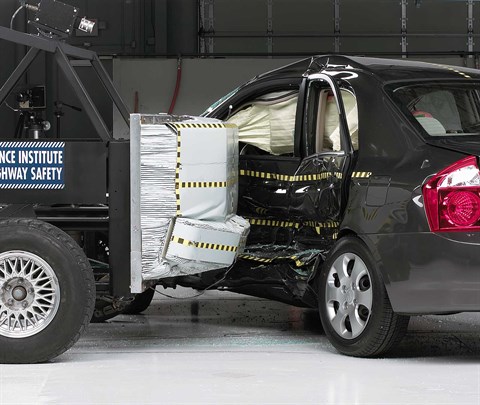
View of the vehicle and barrier just after the crash test.
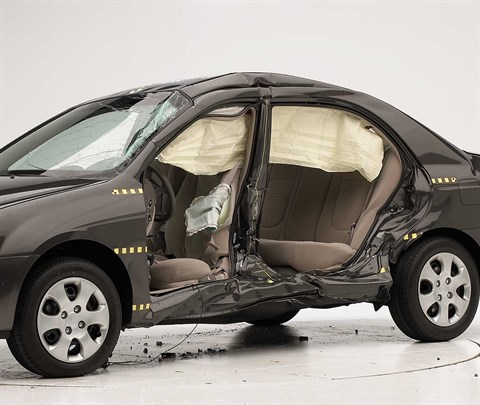
View of the vehicle after the crash with doors removed, showing the side airbags and damage to the occupant compartment.
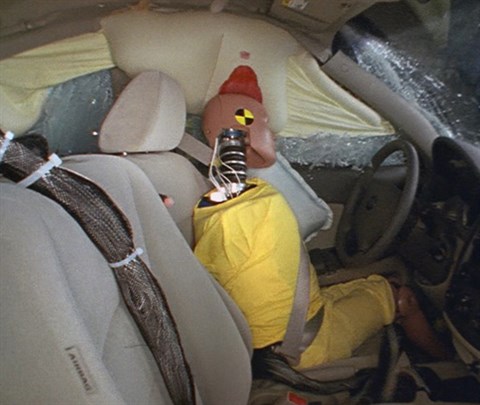
Action shot taken during the side impact crash test showing the driver dummy's head was protected from being hit by hard structures by the side airbags.
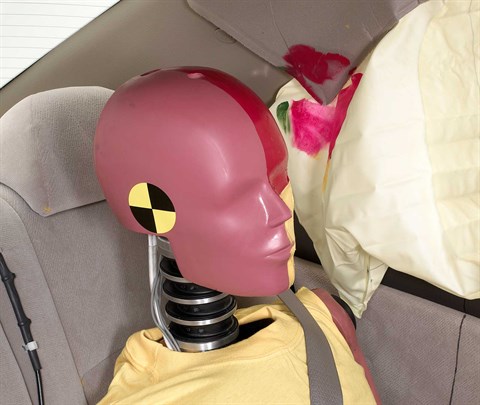
Smeared greasepaint shows where the rear passenger dummy's head was protected by the side airbag.
Measures of occupant compartment intrusion on driver side
| Test ID | CES0422 |
|---|---|
| B-pillar to longitudinal centerline of driver's seat (cm) | -2.5 |
| Negative numbers indicate the amount by which the crush stopped short of the seat centerline. | |
Driver injury measures
| Evaluation criteria | Measurement |
|---|---|
| Test ID | CES0422 |
| Head HIC-15 | 251 |
| Neck | |
| Tension (kN) | 1.1 |
| Compression (kN) | 0.5 |
| Shoulder | |
| Lateral deflection (mm) | 48 |
| Lateral force (kN) | 2.0 |
| Torso | |
| Maximum deflection (mm) | 58 |
| Average deflection (mm) | 53 |
| Maximum deflection rate (m/s) | 7.01 |
| Maximum viscous criterion (m/s) | 2.12 |
| Pelvis | |
| Iliac force (kN) | 3.8 |
| Acetabulum force (kN) | 2.5 |
| Combined force (kN) | 6.3 |
| Left femur | |
| L-M force (kN) | 0.3 |
| L-M moment (Nm) | 160 |
| A-P moment (Nm) | 31 |
Passenger injury measures
| Evaluation criteria | Measurement |
|---|---|
| Test ID | CES0422 |
| Head HIC-15 | 294 |
| Neck | |
| Tension (kN) | 0.3 |
| Compression (kN) | 0.5 |
| Shoulder | |
| Lateral deflection (mm) | 34 |
| Lateral force (kN) | 1.9 |
| Torso | |
| Maximum deflection (mm) | 55 |
| Average deflection (mm) | 35 |
| Maximum deflection rate (m/s) | 6.18 |
| Maximum viscous criterion (m/s) | 1.09 |
| Pelvis | |
| Iliac force (kN) | 0.4 |
| Acetabulum force (kN) | 1.5 |
| Combined force (kN) | 1.7 |
| Left femur | |
| L-M force (kN) | 0.8 |
| L-M moment (Nm) | 297 |
| A-P moment (Nm) | -158 |
Head restraints & seats
Seat type: Seats with active head restraints
| Overall evaluation | |
|---|---|
| Dynamic rating | |
| Seat/head restraint geometry |
| Seat type | Seats with active head restraints |
|---|---|
| Geometry | |
| Backset (mm) | 68 |
| Distance below top of head (mm) | 40 |
| Seat design parameters | |
| Pass/fail | Fail |
| Max T1 acceleration (g) | 10.1 |
| Head contact time (ms) | 87 |
| Force rating | 1 |
| Neck forces | |
| Max neck shear force (N) | 89 |
| Max neck tension (N) | 609 |
Seat type: Seats without active head restraints
| Overall evaluation | |
|---|---|
| Dynamic rating | |
| Seat/head restraint geometry |
| Seat type | Seats without active head restraints |
|---|---|
| Geometry | |
| Backset (mm) | 55 |
| Distance below top of head (mm) | 38 |
| Seat design parameters | |
| Pass/fail | Fail |
| Max T1 acceleration (g) | 12.9 |
| Head contact time (ms) | 86 |
| Force rating | 1 |
| Neck forces | |
| Max neck shear force (N) | 49 |
| Max neck tension (N) | 601 |
About the head restraint & seat test
Currently, IIHS tests apply only to front seats.
